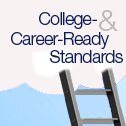One of the major shifts in the Common Core State Standards for English/language arts, as educators know by now, is the focus on nonfiction. In elementary school, about half of what students read should be literature and half should be informational texts, such as essays, speeches, and nonfiction books. By high school, the standards say, just 30 percent of what students read should be literature.
That’s changed how many English/language arts classes are running, a recent New York Times article notes.

“Schools generally choose their own reading materials,” writes Kate Taylor in the Times. “For nonfiction, however, the common-core standards specify that students should read certain ‘seminal U.S. documents of historical and literary significance,’ including the Declaration of Independence, the Bill of Rights, the Gettysburg Address, and the Rev. Dr. Martin Luther King Jr.'s ‘Letter From Birmingham Jail,’ as well as presidential addresses and Supreme Court opinions. Many high schools have added these to American literature classes.”
As Taylor explains, there are mixed reviews on whether reading more nonfiction in schools is a good thing. But the article fails to explain an element of the literacy standards that’s become critical to these conversations: The reading standards aren’t meant just for English classes. They’re supposed to be taught across the grade.
The standards promote an “interdisciplinary approach to literacy,” stating that “college- and career-ready students [need] to be proficient in reading complex informational text independently in a variety of content areas.”
And while it’s buried in a footnote, the standards also explicitly state that the required percentages for nonfiction “reflect the sum of student reading, not just reading in ELA settings.”
So, “Letter From Birmingham Jail"—could very well be read in a 9th grade history class rather than a literature class. (It’s also worth noting that there are no particular texts required by the common core—the texts listed in the document are simply examples.)
In a follow-up piece, Taylor explained that she’d started her reporting by calling New York and New Jersey districts to ask how they’d changed their language arts curricula since the common core was put into place.
From what I’ve heard, Taylor is right—English teachers are feeling the heat for implementing the reading standards. But perhaps it would be just as telling to ask districts how they’ve changed their social studies or science curricula. Is there more reading going on in those subjects? How are content-area teachers helping students reach those nonfiction percentages?
See also:
